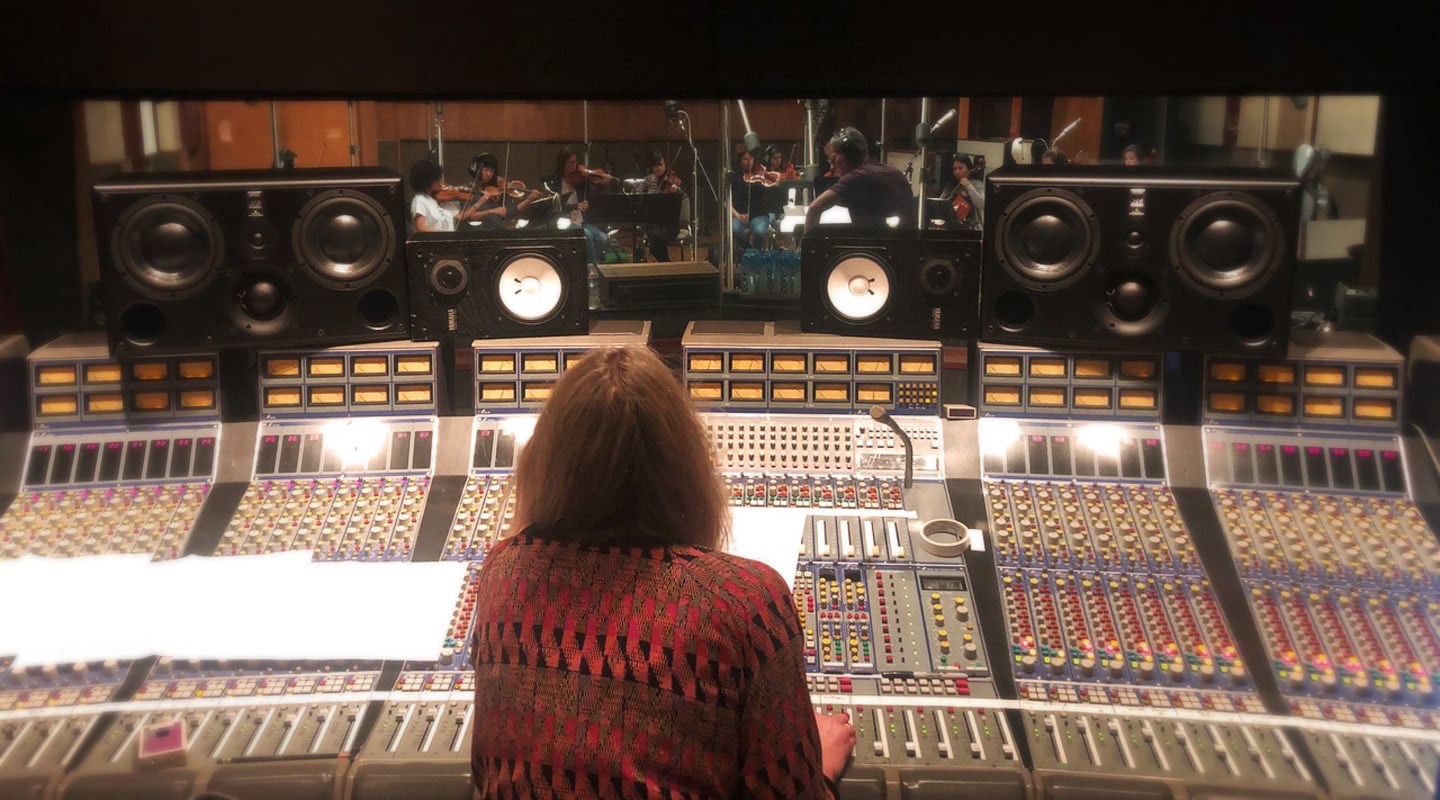
Tag Team: Producing Alanis Morissette
Aussies Alex Hope & Catherine Marks Produce ‘Such Pretty Forks in the Road’

Artist: Alanis Morissette
Album: Such Pretty Forks in the Road
When Alanis Morissette jumped onto the international stage in 1995 with her megahit album Jagged Little Pill, she gave voice to female issues as no songwriter had done before her. Given how strongly Morissette has been associated with women’s issues during her career, it’s been striking that she’s always worked with male co-writers and producers, big names like Glen Ballard, Tim Thorney, John Shanks, Guy Sigsworth, and Joe Chiccarelli.
Such Pretty Forks in the Road, released last summer and Morrisette’s first studio album since Havoc and Bright Lights (2012), breaks the mould. Although Morissette co-wrote all songs with the keyboardist and musical director of her live band, Michael Farrell, the production of the album’s 11 songs was divided between two women: Alex Hope produced five and Catherine Marks six. The two also are both Australian, but there the similarities end — at least in terms of their musical careers and production approaches.
The different ways in which Hope and Marks approached production before they worked with Morissette are emblematic of the dramatic changes in the music industry during the last few decades. Marks’ production approach has its roots strongly in the 20th century: she is someone who tends to work with bands and artists who play instruments in the studio and who are predominantly in the rock arena — witness credits like PJ Harvey, Wolf Alice, Foals, The Big Moon, St Vincent, Manchester Orchestra, and The Amazons.
Marks’s approach to engineering and mixing flows from this, while producing mostly involves getting the best out of artists and the songs they write. While she’s a proficient pianist, she rarely plays on the albums she’s involved in making. The fact her main mentors have been music industry legends Flood and Alan Moulder — known for their ground-breaking work with U2, The Killers, The Smashing Pumpkins, and many more — further illustrates the roots of her approach.
By contrast, at 26, Alex Hope is a generation younger, in music industry terms at least, and the archetypal 21st century pop producer. Hope co-writes songs with the artist (and often others as well — modern pop songs usually have multiple writers) and if she then also produces the song, she plays and programs the arrangements, and handles sonics and the rough mix. She does all this on her computer, mostly alone at home. Artists who have benefitted from her talents include Taylor Henderson (Hope co-wrote his 2013 Aus No.1 hit Borrow My Heart), Troye Sivan, Tina Arena, Years & Years, Carly Rae Jepsen, David Guetta, and Selena Gomez. Tellingly, Hope’s production references, are 21C pop producers like Max Martin, Jack Antonoff, and Joel Little.
MELBOURNE & SYDNEY: TALE OF 2 CITIES
Marks is from Melbourne, and Hope grew up in Sydney. They both furthered their careers by heading overseas, with Marks since 2005 based in London, working mostly at the Assault & Battery studio complex; while Hope moved to LA in 2014, where she tends to work from her home studio. Talking from their respective studios, the two producers elaborated on their work with Alanis Morissette, which, entirely in line with the singer’s penchant for introspection and personal growth, also led the two producers on a path of self-development, and a widening of their horizons.
On Instagram, Marks calls working with Morissette, “one of the highlights of my career. Getting to work with such an incredible voice and human being”. On the same platform, Hope remembers that when she received the news of Morissette’s camp making contact in 2018, she was “running around the hotel room like a lunatic until my manager thought I’d truly lost it (…) I’m often asked what my dream project would be. That one artist. That one storyteller. That one voice.”
Via Skype, Hope added, “Yes, Alanis has long been a hero of mine. And working with her was incredible. I never even thought that me working with an artist like her would even be a possibility. She is amazing, as a person, as an artist, as a writer, just everything.”
Marks and Hope clearly are big fans. They both relate that Morissette making contact with them was in part driven by a conscious decision on the singer’s part to work with female producers for this album. “This obviously was great,” commented Marks, “because it gave me the opportunity to work with her. But I didn’t think of the album as being made by women. Obviously, this being Alanis, the songs were very personal and sensitive, and as a woman I could relate to the female point of view that’s expressed, and could treat that with a certain amount of sensitivity. But I think it’s more about being the right person for the job, rather than being male or female.”
Once contact was made, finding the right person involved Morissette choosing which songs were to be produced by Marks, and which by Hope. “When she played us the songs,” elaborates the latter, “we had to be on the same page as her in terms of the artistic visions for each of them. I also think that for Alanis, it’s about the human connection, as much as the same musical vision. At the same time, she gave both of us a lot of freedom. She was very trusting in saying: ‘do your thing’. So I was given the space to make things a bit poppier or whatever. I think she wanted me to bring those aspects in. I feel I had her blessing to play around in my safe space, even as she would obviously tell me if something did not feel right to her.”
Alanis is an indie girl at heart and she loves weird as much as I do, and I think my production style on her songs reflects that


CREATIVE TRUST
The five songs produced by Hope on Such Pretty Forks in the Road are indeed ‘poppier’ and have more of the instant impact that is the hallmark of 21C pop production styles. One assumes that it is for this reason that the choice was made to sequence four of these songs at the beginning of the album, and that three of them were released as the album’s first singles: Reasons Why I Drink, Smiling, and Diagnosis. By contrast, the songs produced by Marks are more like deep and offbeat album tracks.
“Alanis was brilliant in the way that she divided up the tracks between us,” explained Marks. “My first track was Pedestal, and I think Ablaze was Alex’s first song. From that, Alanis was able to gauge what we did to those songs, and she then assigned the songs according to how suitable she felt our ways of production were. It was obvious that Alex and I had different approaches in the way that we treated and constructed the productions of the songs. Alanis is an indie girl at heart and she loves ‘weird’ as much as I do, and I think my production style on her songs reflects that. After sending Alanis the first draft of Pedestal I remember she sent me a message saying how much she loved it and for me to keep doing my thing. The creative freedom and trust she gave us was incredible.”
WORKFLOW
Over the long period that Hope and Marks worked on the album, off and on over nearly two years during 2018 and 2019, Morissette sent each producer piano/vocal demos of the songs, which she had recorded at her home, using an AKG C12 on her voice, with co-writer Michael Farrell on piano. At this point, Hope and Marks worked separately. Hope would load Morissette’s piano/vocal demos into Logic, her preferred DAW, and she then arranged and produced them to full-blown tracks.
“Catherine and I had agreed that we did not want it to be a piano record, so we each set about creating arrangements with many other instruments. On Smiling, for example, I replaced the piano with a guitar. In fact, I played all guitars on the tracks I produced, using a combination of my pedal board and amps, and DI and plug-ins for the cleaner sounds.”
“My reference, also for my guitar sounds, was the sonics of Jagged Little Pill, while still making things sound current. I also programmed drums, bass, and synths, and I wrote string arrangements. I did not want to use tons of synths and make it sound too like the pop of today. So I did mock-ups of the arrangements in Logic, and then later a number of these parts were replaced by real players, at drummer Victor Indrizzo’s Sage & Sound studio, while live strings were overdubbed to one of my songs and one of Catherine’s songs at United Recording in Hollywood.”
“I could hear the groove I wanted in each song, so I programmed that, and then later in his studio I let Victor play around with it. I told him to go crazy on his drums at the end of Smiling, and that’s what he did, and I loved it. Michael [Farrell] also added piano. My friend Tyler Last, with whom I want to college at the Australian Institute of Music came to my home studio to play bass in a couple of songs.”
Hope spent a lot of time in her studio selecting the best takes, comping and treating the recordings. “I’d go through everything in Logic, and I’d then work on bringing the track to a place where I could give the mixer, Chris Dugan, a reference mix. I worked extensively on that, using my favourite plug-ins. I particularly love the Waves RCompressor, H-Delay, and Q10, the Soundtoys Decapitator, particularly on drums, the FabFilter Pro-Q3 EQ, and the Valhalla Room, Vintage Verb, and Shimmer.”
In addition to Logic, with a large selection of plug-ins, Hope’s studio consists of an Apollo x8p interface, Dynaudio BM6A monitors (though she recently obtained Barefoot Sound MicroMain 27 gen2 monitors), quite a few keyboards, amongst them a Roland Juno, Korg MiniMoog, and Korg Sub 37, tons of electric and acoustic guitars, guitar pedals, an upright piano (“game-changing”) and a small drum kit. Hope says she’s a big fan of both hardware and soft synths, and her favourites amongst the latter are Spectrasonics Omnisphere, Korg Polysix, everything by Arturia, Native Instruments Massive and Xfer Serum, while she’s built up a huge sample collection over the years, augmented by samples she downloads from Splice.com.
ALEX HOPE STUDIO GEAR
- Barefoot MicroMain 27 Gen 2 Monitors
- UA Apollo 8p
- Rupert Neve Shelford Channel
- Novation MIDI Controller
- Presonus Monitor Station
Mics:
- Shure SM7B
- Aston Origin, Spirit, 2 x Starlights on upright piano
- Rode NT2-A and 2 x NT1
- Shure SM57B with Cloudlifter
Keys:
- Roland Juno 106
- Moog Sub 37
- Korg Minilogue
- Roland System 8
- Roland GAIA
- Upright Baldwin Piano
Instruments:
- Fender Mustang
- Fender P Bass
- Fender Telecaster
- Taylor GS Mini Acoustic
- Silvertone Electric
- Cole Clark Telecaster Model
- 2 Martin Acoustic Guitars
- Fender Blues Junior Amp
- 60s Pearl Drum Kit
Pedals:
- Strymon: Big Sky, Volante, El Capistan, Mobius
- Electro-Harmonix: Deluxe Memory Man, Pitch Fork, Attack Decay, Mel 9, Holy Grail Reverb

THE AUDACITY OF HOPE
For Hope, several aspects of working on Such Pretty Forks in the Road were unusual. “Yeah, this definitely was a new experience for me,” agreed Hope. “Normally, artists come to my studio, and we start from scratch. The artist may come in with a feeling, or a sentence, or a story of an experience, or a verse idea, and I try to connect with that and then help them flesh out the song. I prepare sessions with drums and other sounds that work together, so that I can load these once I know where the artist is at. Usually, the artist initiates the direction, but I am very much part of helping them develop that.”
“When I work with artists I am a little bit like a therapist, because I want to make sure that we’re writing about something that comes from a real place, and is not just generic. I want to work on stuff that’s like therapy for the artist, and therefore relatable and hopefully therapeutic for anyone who listens to it. But Alanis came in with fully written songs, and she also is someone who is arguably the best at telling the unfiltered personal truth. I just loved that. We had long conversations because I really wanted to hear what the songs were about before I dived into producing them and creating musical worlds for them to sit in. All this definitely was a very different process for me.”
“My main focus was not to get in the way of Alanis’s storytelling. I did not want to re-write or anything, or my production to compete with Alanis in any way, but instead I wanted it to enhance the feel and meaning of her songs. This meant that I used many of her demo vocals, because they were recorded in the moment when she just had written the song. I loved these performances, but because they were spontaneous, it meant that I had to use Melodyne to tweak some details.
“There were some background noises on some of these demo vocals that I had to EQ out. I did put everything on a grid, so I nudged some vocals around in time to get them to fit. In the places where I couldn’t, we’d punch in a word or line here and there during sessions later on. I didn’t time stretch any of these original vocals. One song for which I didn’t use the demo vocals is Reasons I Drink, for which Alanis later re-sang the entire song, with Michael on piano, to a click.”
FINISHING IN L.A.
Like Hope, Marks travelled to Sage & Sound and United Recording Studios in Los Angeles to track guitars, keyboards, bass, drums, strings, and also many of Morissette’s vocals. “We retracked her vocals for Her and Nemesis entirely,” explained Marks, “eventually settling on a Shure SM7 for her — I think we used an AKG C12 on Nemesis. The demo vocals were gorgeous but I had adjusted some of the tempo shifts a little and these vocals didn’t scan as nicely. I had tempo mapped both the demo piano and vocal, therefore, if anything was overdubbed, whether it was keys or vocals or drums, it was played to the original performance of the demo.
“Sometimes we used a click, sometimes we didn’t. It felt natural to play to the performance of the original vocals and the keys in this way. It worked great with Nemesis, with Victor’s drums being his first take, and he coped wonderfully with the intense tempo shift before the middle eight. The guys jammed together on that song, with David Leita adding an offbeat guitar part, Michael playing synths, and Cedrik Lemoyne on bass. The very end of Nemesis is a brilliant performance from the guys. The jam at the end felt so good we decided to leave it in.”
Like Hope, Marks returned to her studio in London after the LA recording sessions, where she said she “mucked around with the tracks some more, getting them ready for Chris Dugan to mix. Though actually, I didn’t do that much to the tracks, as I had prepped everything before I went to LA. I’d more or less rough mixed everything in LA, either in the studio, or on my laptop in my hotel room using my Sony MDR-7506 headphones or a pair of Beats by Dre. In my studio it was more about final arrangement choices and vocal tweaking.”
Before sending their sessions to Dugan for mixdown, Marks and Hope came together to compare notes. “We spent a couple of days together to make sure the entire album sounds cohesive and to smooth out all the edges, and to do final touches and finish stuff off,” recalled Hope “This was when Alanis came in, and she was listening to everything and giving us her notes and feedback. Catherine and I also really wanted to make sure we matched the vocal sounds we got for Alanis.”
Today’s pop vocals are very bright, so it’s unsurprising that Hope went for this sound. In this case Marks followed suit. “I had gone very dark initially on Alanis’s vocals, heavily compressing them and pushing the midrange tone a lot. But even though our production of the songs is very different, we needed a vocal sound on the album that was continuous. It was a creative decision to make things cohesive, and I made the vocals in my sessions sound more like those in Alex’s productions. In the end we used the same plug-ins, which were the Waves RCompressor and Q10 EQ, and the Valhalla Room. But ultimately Chris and Alanis were in charge of how the vocals sounded, as they finalised things.”
we’d punch in a word or line here and there during sessions later on. I didn’t time stretch any of these original vocals


MARKS ON TARGET
Over in London, Catherine Marks related a similar tale of having to stretch and learn new approaches to production, but in the opposite direction. Where Hope had to explore 20C production methods, Marks was thrown in the deep end in having to quickly develop a very 21C skillset.
“My process in my career has been helping and directing musicians and bands, and in this case I had to be the band, in a way. I’d look at the piano/vocal demos I had been given and what I could add to enhance the song. So I was demoing the arrangements in Pro Tools, which I had never done before. For Alex it was part of her remit, whereas I had to suddenly use a different part of my brain.
“I’m classically-trained as a pianist, and I played in bands when I was younger, but since I have been producing, my role has been more about guiding and facilitating the artists. Years ago when I was working with Alan [Moulder], I remember he suggested that I focus on one particular discipline, mixing, and that I become really good at that, and he said that everything else then will fall into place. That is exactly what happened. Over the years I have little by little been able to explore different sides of production. And mixing to me is finishing, and when I am recording and producing it is going to tape the way I want it to sound at the end. I want all solutions to have been achieved in the production process, and the final mix is just to enhance that.”
In building arrangements and a production in-the-box for Morissette’s piano/vocal demos, Marks worked in a similar way to Hope. But there were a few differences, informed by her experience as a producer. “Before anything,” began Marks, “my reactions to Alanis’s songs was quite emotional, and I was trying to eke out every emotion Alanis was trying to convey. I was trying not to overpower the songs and be tender and sensitive with the production. The only exception is a track called Nemesis, in which we went all out.
“When working on the songs, I first had to figure out what the chords were. Next was figuring out an appropriate groove. When I’m working with bands in pre-production, the first thing I often do is break down what the groove is, and help them build it up, so it supports the vocals and the song. With Alanis, I made the decision not to put songs on a grid. There was a rising and falling of the tempo in the piano/vocal demos that I liked, and when I put them on a grid, it did not feel the same to me. There was something about the natural performance that felt really right, and that I wanted to keep. So I tempo-mapped the songs which involves manually finding the one of each bar. It was a lot of work. The smartest thing Alex did was put everything on a grid!” (laughs)
“After tempo-mapping and treating the piano and the vocal sounds, I started experimenting with sonics and textures. I first reached for what I was familiar with: guitars. So I invited Chris Alderton from The Amazons and Frank Turner, who I had just done an album with, to come to my room at Assault & Battery. I knew what tones I wanted and what the notes were, and they then created their own guitar to parts around that.
“I also programmed drums, which I wanted to be delicate, almost percussive. I used samples I had previously made and I processed them out of the box with pedals and outboard gear, trying to get the most organic sound possible, with the idea of eventually replacing the programmed drums with live drums. When Alanis had heard the initial production ideas we discussed replacing a lot of the programming with live drums using the programmed grooves as templates. This was exciting to me as I love the natural performances of human players.
“Then I played some piano and wrote some string lines, using a soft synth or a Solina or keyboards. I also did a lot of backing vocals, which I tuned and processed, again using pedals, so my vocals were more like sonic textures. The two pedals I used the most were the Cicognani Limited Edition Echosex 2 and the ElectroHarmonix Holy Grail.”
CHANGING TRACKS
With all said and done, both Hope and Marks feel working on Such Pretty Forks in the Road changed them, with the former ready to take on more 20C-style productions, while Marks added, “It definitely change the way I work. I feel a lot freer with much more of a no-rules approach. Since the Alanis record I have been playing a lot more, and I have started doing a lot of song-writing with other artists. I am also working more on indie pop mixes with female vocalists. My confidence is up, and this has inspired me to explore other sides of my creativity.”
And finally, on the topic of Such Pretty Forks in the Road having been made by three women, one hopes that this will soon be so commonplace that it no longer needs addressing. Looking back, do Hope and Marks feel that it made a difference? “Yes,” replied Hope, “although I’m not sure the end result is necessarily different. Men and woman can all make music in similar ways. I think it just felt really comfortable for me to work with another woman, despite me being such a big Alanis fan and feeling this was like the biggest thing ever!”
“I don’t think the end result was necessarily different,” echoed Marks. “but I feel very fortunate to have explored something I have always wanted to explore, and Alanis took a chance and gave me the opportunity. Her songs spoke to me, and what I did with them spoke to her, thankfully. So there was a genuine connection, through music.”

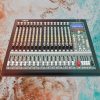








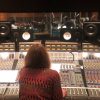




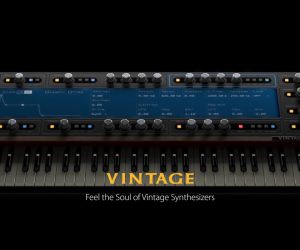







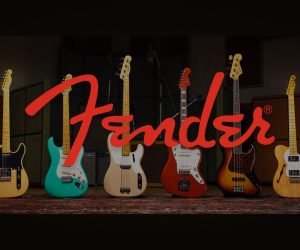


RESPONSES